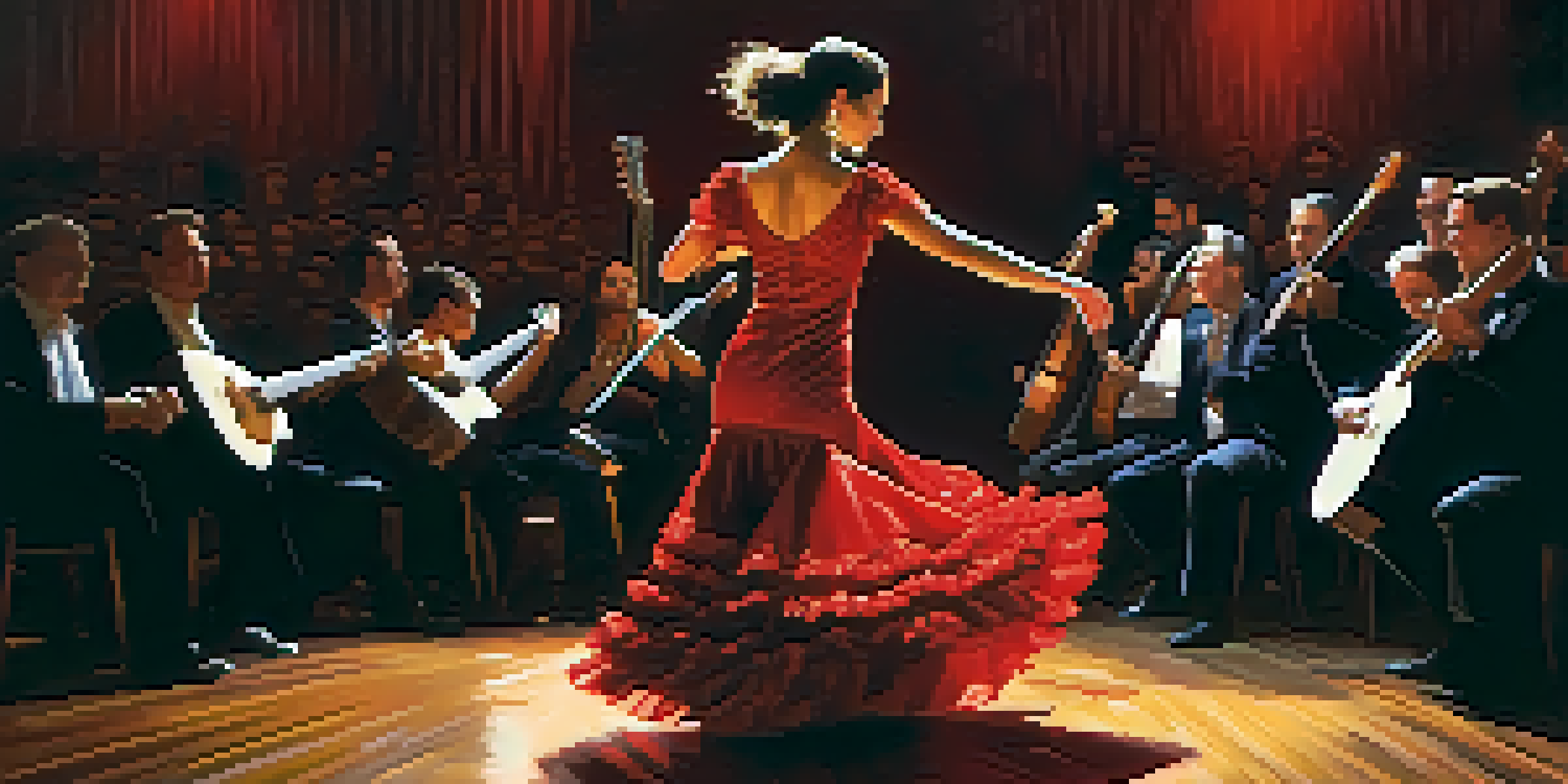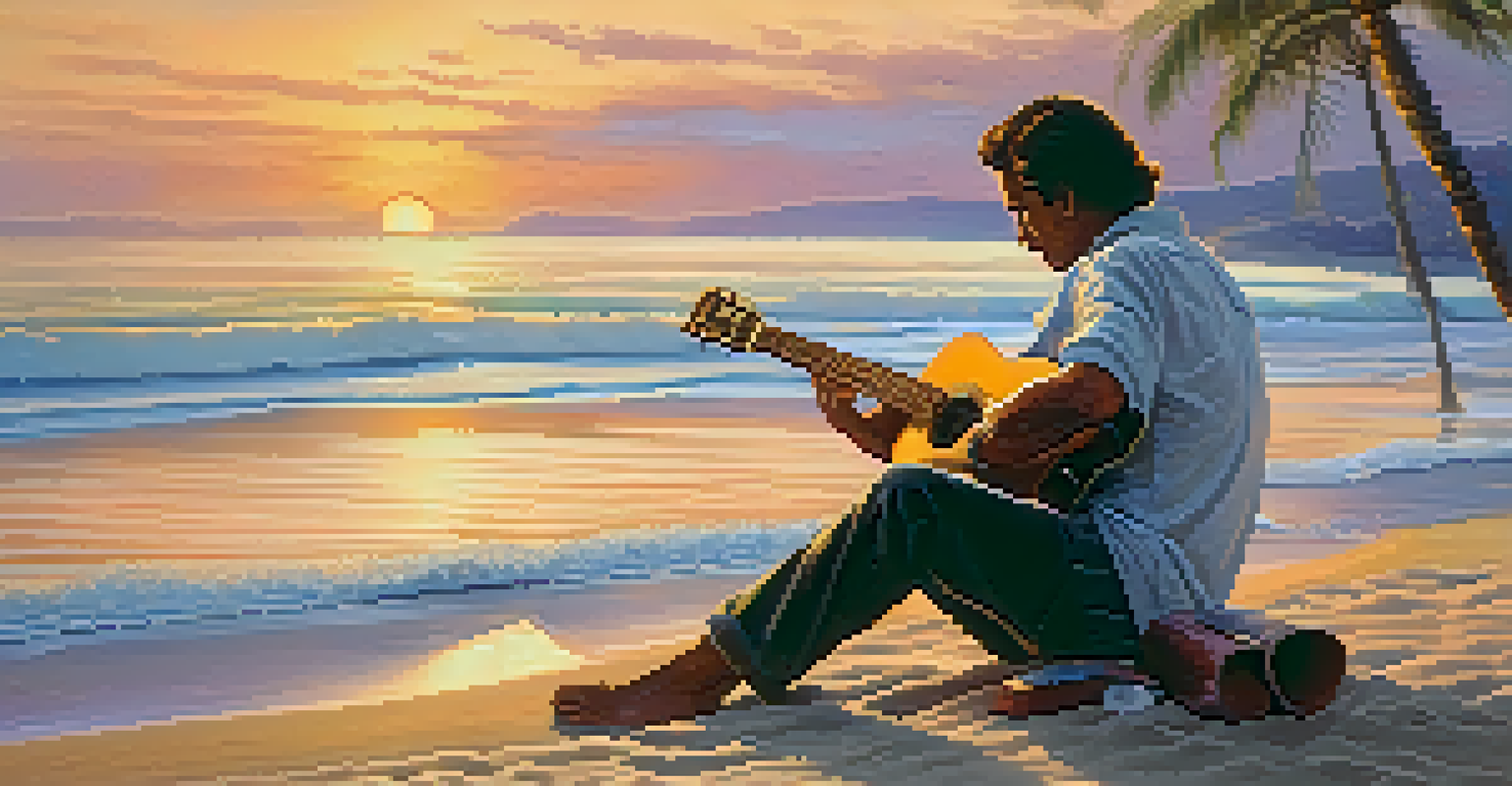Latin Guitar Styles: A Journey Through Rhythm and Melody

An Introduction to Latin Guitar: A Musical Heritage
Latin guitar is more than just an instrument; it's a cultural tapestry woven from diverse musical traditions. From flamenco to bossa nova, each style carries its own unique flavor and history, reflecting the regions from which they originate. This journey through Latin guitar will uncover the deep rhythms and melodies that have captivated audiences worldwide. Whether you're a seasoned guitarist or a curious listener, understanding these styles opens a door to rich musical experiences.
Music can change the world because it can change people.
At its core, Latin guitar embodies the fusion of various influences, including African, Spanish, and indigenous sounds. This blend results in a vibrant array of genres, each with its distinct techniques and emotional expressions. For instance, flamenco guitar showcases intricate fingerpicking and rapid strumming, while bossa nova introduces a laid-back syncopation that invites relaxation. It's this diversity that makes Latin guitar so compelling, as it invites exploration and appreciation.
As we delve deeper into specific styles, we'll discover how the techniques and rhythms come together to create a captivating narrative. Each strum and pluck tells a story, whether it’s the passion of a flamenco performance or the smooth sway of a bossa nova tune. Join us as we explore these enchanting styles and uncover the secrets that make Latin guitar a beloved genre around the globe.
Flamenco Guitar: Passion and Precision in Performance
Flamenco guitar is often described as the heartbeat of Spanish culture, pulsating with energy and emotion. Originating from the Andalusian region, this style combines intricate finger techniques with powerful strumming patterns, creating a sound that is both delicate and fierce. The beauty of flamenco lies in its improvisational nature, allowing guitarists to express their feelings in the moment. This spontaneity adds a layer of excitement, making each performance unique.

One of the hallmarks of flamenco is the use of techniques like 'rasgueado' (strumming) and 'picado' (plucking), which require both skill and flair. These methods create a rhythmic foundation that complements the expressive singing and dancing often associated with flamenco performances. For those learning the style, mastering these techniques can be daunting, but the rewards are immense as they unlock a deeper connection to the music and culture.
Diverse Styles Define Latin Guitar
Latin guitar encompasses a variety of styles, each with its own unique techniques and cultural significance.
Moreover, flamenco is not just about the guitar; it’s a holistic experience that involves the dancer's movements and the singer's emotive voice. This synergy creates a powerful atmosphere that resonates with audiences. By understanding the intricacies of flamenco guitar, one gains insight into the cultural significance and emotional depth that define this electrifying musical style.
Bossa Nova: The Cool Breeze of Brazilian Music
Bossa nova, often celebrated as the 'new wave' of Brazilian music, emerged in the late 1950s and quickly became a global sensation. Characterized by its smooth melodies and laid-back rhythms, bossa nova blends samba and jazz elements, creating a soothing yet intricate sound. The guitar plays a central role in this style, with its soft strumming patterns providing a gentle backdrop to the silky vocals and breezy melodies. It's music that feels like a warm day on the beach, inviting listeners to unwind.
The guitar is a miniature orchestra in itself.
The signature bossa nova rhythm, known as 'batida,' incorporates syncopated patterns that give the music its characteristic feel. This rhythm, combined with complex chord progressions, creates a rich harmonic landscape that is both inviting and sophisticated. For guitarists, mastering bossa nova involves not only technical proficiency but also an understanding of its subtleties and nuances. It’s about more than just playing notes; it’s about conveying a mood.
As we listen to classics like 'The Girl from Ipanema' or 'Desafinado,' we can appreciate how bossa nova captures the essence of Brazilian culture. It’s a style that tells stories of love, longing, and the beauty of everyday life. By exploring bossa nova guitar, musicians and listeners alike can appreciate the artistry that has made this genre a timeless treasure in the world of music.
Samba: A Rhythmic Celebration of Life
Samba is arguably one of the most iconic musical styles to emerge from Brazil, known for its infectious rhythms and vibrant energy. Rooted in African traditions, samba celebrates life and community, often accompanied by lively dance and festivities. The guitar in samba plays a pivotal role, laying down the rhythmic foundation that drives the music forward. It’s a sound that embodies joy and celebration, making it irresistible to dance to.
In samba, the guitar often employs a technique called 'chordal strumming,' which allows for a rich, full sound that complements the other instruments in the ensemble. This style often features rapid changes between major and minor chords, creating a dynamic and engaging listening experience. For those learning samba guitar, the challenge lies in mastering the timing and rhythm, which are crucial for capturing the essence of this lively genre.
Flamenco: Emotion in Every Note
Flamenco guitar is marked by its improvisational nature, allowing musicians to express deep emotions through intricate playing.
Beyond the music, samba represents a cultural movement that embraces diversity and unity. It’s a genre that has evolved over the years, incorporating elements from various musical traditions while maintaining its core rhythmic identity. By understanding samba guitar, musicians not only connect with its rich history but also become part of a larger celebration that transcends borders and brings people together.
Rumba: The Heartbeat of Afro-Cuban Music
Rumba is a vibrant musical genre that originated in Cuba, deeply rooted in African traditions and influences. It’s known for its lively rhythms and expressive dance, making it a staple of Cuban culture. The guitar in rumba serves as both a melodic and rhythmic instrument, often layering intricate lines over the percussive backdrop provided by drums and other instruments. This combination creates a captivating sound that invites listeners to move and feel the music.
The guitar techniques used in rumba, such as 'tresillo' patterns, create a distinctive groove that is both engaging and complex. These patterns often involve syncopation, giving the music a sense of forward momentum. For aspiring guitarists, learning rumba means immersing themselves in its rhythmic intricacies and understanding how to interact with other musicians in an ensemble setting.
Rumba is not just a musical style; it’s a celebration of life, community, and culture. It tells stories through its rhythms and melodies, often reflecting the struggles and joys of everyday life. By embracing rumba guitar, musicians can connect with a rich cultural legacy while also enjoying the infectious energy that this genre brings to the stage.
Tango Guitar: The Dance of Emotion and Elegance
Tango, often associated with the passionate dance of the same name, has a rich musical tradition that captivates audiences worldwide. Originating in Argentina, tango music is characterized by its dramatic melodies and intricate rhythms, with the guitar playing a key role in setting the mood. The guitar’s ability to convey emotion makes it an essential instrument in tango ensembles, where it complements the haunting sounds of the bandoneón and violin.
In tango, guitarists typically use a combination of strumming and fingerpicking techniques to create a lush, expressive sound. The rhythms are often syncopated, providing a sense of urgency that mirrors the dance's passionate movements. For those learning tango guitar, it’s important to focus on the expressive qualities of the music, allowing the emotions to come through in each note played.
Bossa Nova: Relaxing Rhythms
Bossa nova combines smooth melodies and syncopated rhythms, creating a soothing sound that captures the essence of Brazilian culture.
Tango music tells stories of love, loss, and longing, often reflecting the complexities of human relationships. The interplay between the guitar and the other instruments creates a rich tapestry of sound that captures the listener’s imagination. By exploring tango guitar, musicians not only develop technical skills but also engage with a powerful emotional narrative that resonates deeply within the heart.
Conclusion: Embracing the Diversity of Latin Guitar Styles
As we conclude our journey through the world of Latin guitar styles, it becomes clear that each genre offers its own unique voice and cultural significance. From the fiery passion of flamenco to the smooth elegance of bossa nova, the guitar serves as a bridge connecting us to diverse traditions and emotions. Each style invites musicians and listeners alike to explore new rhythms and melodies, enriching our musical experiences.
The beauty of Latin guitar lies in its diversity, allowing for endless exploration and creativity. Musicians can draw inspiration from various styles and blend them to create something entirely new. This adaptability reflects the spirit of Latin music, which thrives on collaboration and innovation. By embracing these different genres, we can honor their roots while also contributing to their evolution.

Ultimately, the journey through Latin guitar is one of discovery and connection. Whether you’re strumming your first chord or performing on stage, each note carries a story that transcends borders. By immersing ourselves in these rich musical traditions, we not only enhance our skills but also celebrate the vibrant tapestry of cultures that continue to inspire us.